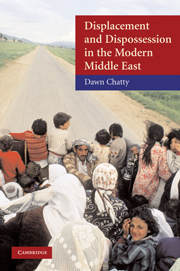Book contents
- Frontmatter
- Contents
- List of Tables
- List of Charts and Maps
- Acknowledgements
- Introduction: Dispossession and Forced Migration in the Middle East: Community Cohesion in Impermanent Landscapes
- 1 Dispossession and Displacement within the Contemporary Middle East: An Overview of Theories and Concepts
- 2 Dispossession and Forced Migration in the Late Ottoman Empire: Distinct Cultures and Separated Communities
- 3 Circassian, Chechnyan, and Other Muslim Communities Expelled from the Caucasus and the Balkans
- 4 The Armenians and Other Christians: Expulsions and Massacres
- 5 Palestinian Dispossession and Exodus
- 6 Kurds: Dispossessed and Made Stateless
- 7 Liminality and Belonging: Social Cohesion in Impermanent Landscapes
- Bibliography
- Index
1 - Dispossession and Displacement within the Contemporary Middle East: An Overview of Theories and Concepts
Published online by Cambridge University Press: 05 June 2012
- Frontmatter
- Contents
- List of Tables
- List of Charts and Maps
- Acknowledgements
- Introduction: Dispossession and Forced Migration in the Middle East: Community Cohesion in Impermanent Landscapes
- 1 Dispossession and Displacement within the Contemporary Middle East: An Overview of Theories and Concepts
- 2 Dispossession and Forced Migration in the Late Ottoman Empire: Distinct Cultures and Separated Communities
- 3 Circassian, Chechnyan, and Other Muslim Communities Expelled from the Caucasus and the Balkans
- 4 The Armenians and Other Christians: Expulsions and Massacres
- 5 Palestinian Dispossession and Exodus
- 6 Kurds: Dispossessed and Made Stateless
- 7 Liminality and Belonging: Social Cohesion in Impermanent Landscapes
- Bibliography
- Index
Summary
We came in carts – big carts – we didn't stop. Eating and drinking were all done in the carts – all the way from Abkhazia to Sham [Syria]. What can I say? Death would have been much better. When a person dies, he is rested. But those grandfathers of ours suffered a lot, as no other people ever did. They came from Abkhazia in carts, as I told you, all the way through Turkey to the Jaulan. In the Jolan, you know, it was like implanting a piece of wood in a member of your body. If a piece of wood were inserted in your arm, would your arm accept it? It has been continuous tragic mishaps and suffering. Then, just when we started to belong, to become rested, and as if to make things worse, the Jews took over and we were driven out. We left the Jolan empty-handed with nothing but the clothes on our backs.
Abdul-Salam (2005)INTRODUCTION
Abdul-Salam was 93 years old when he recalled the story of his parents' and grandparents' dispossession, eviction, and forced march out of the Northern Caucasus at the end of the nineteenth century during one of the many Russian–Ottoman wars. The Russian Imperial Empire, determined to expand south and west, had conquered the Ottoman Empire's borderlands in Abkhazia, sending hundreds of thousands of Muslim peasant and Jewish artisanal and trader families south and west into Anatolia and the Syrian provinces of the Ottoman Empire.
- Type
- Chapter
- Information
- Publisher: Cambridge University PressPrint publication year: 2010
- 1
- Cited by



